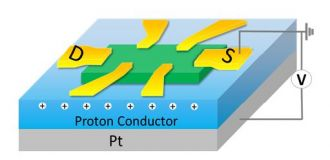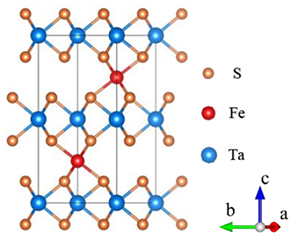| Jun 16, 2021 |
Inducing and tuning spin interactions in layered material
(Nanowerk News) Magnetic-spin interactions that allow spin-manipulation by electrical control allow potential applications in energy-efficient spintronic devices.
|
|
An antisymmetric exchange known as Dzyaloshinskii-Moriya interactions (DMI) is vital to form various chiral spin textures, such as skyrmions, and permits their potential application in energy-efficient spintronic devices.
|
|
Published in Nature Communications ("Tailoring Dzyaloshinskii-Moriya interaction in a transition metal dichalcogenide by dual-intercalation"), a Chinese-Australia collaboration has for the first time illustrated that DMI can be induced in a layered material tantalum-sulfide (TaS2) by intercalating iron atoms, and can further be tuned by gate-induced proton intercalation.
|
 |
| Hall-bar device on solid proton conductor, used to measure Hall resistivity under different conditions. (Image: FLEET)
|
Realizing and tuning DMI in van-der-Waals material TaS2
|
|
Searching for layered materials that harbour chiral spin textures, such as skyrmions, chiral domain Walls is vital for further low-energy nanodevices, as those chiral spin textures are building blocks for topological spintronic devices and can be driven by ultra-low current density.
|
|
Generally, chiral spin textures are stabilized by DMI. Therefore, introducing and controlling DMI in materials is key in searching and manipulating the chiral spin textures.
|
|
“Tantalum-sulfide is one of the large family of transition metal dichalcogenide (TMDCs) investigated by FLEET for low-energy applications,” says the study’s first author, FLEET Research Fellow Dr Guolin Zheng (RMIT).
|
|
The team firstly successfully realized a sizable DMI in the layered material tantalum-sulfide by intercalating Fe atoms.
|
|
However, electrically controlling the DMI turns out to be challenging: “Both conventional electric-field gating, and the widely-used alternative technique of ion-liquid (Li+) gating have hit stumbling blocks in the electrical control of DMI in itinerant ferromagnets, because the electric-field and Li+ can only modulate the carriers close to the surface,” explains Guolin.
|
|
To address this limitation in tuning the DMI, the group at RMIT recently developed a new protonic gate technique, and successfully illustrated that DMI can be dramatically controlled by gate-induced proton intercalations.
|
|
By increasing the intercalation of protons by gate voltage, the team were able to significantly change the carrier density and further tune the DMI via the Ruderman-Kittel-Kasuya-Yosida (RKKY) mechanism, which refers to the coupling of nuclear magnetic moments.
|
 |
| Crystal structure, showing iron atoms (red) in tantalum-sulfide structure. (Image: FLEET)
|
|
“The observed topological Hall resistivity after proton intercalation has been increased more than four-fold under a few volts, indicating a huge increase of DMI,” says co-author A/Prof Lan Wang (also at RMIT).
|
|
“The successful tuning of DMI in chiral magnet Fe-intercalated TaS2 by protonic gate enables an electrical control of the chiral spin textures as well as the potential applications in energy-efficient spintronic devices,” says co-author Prof Mingliang Tian, who is a FLEET Partner Investigator and Director of the Centre’s partner organisation the High Magnetic Field Laboratory (Anhui Province, China).
|


